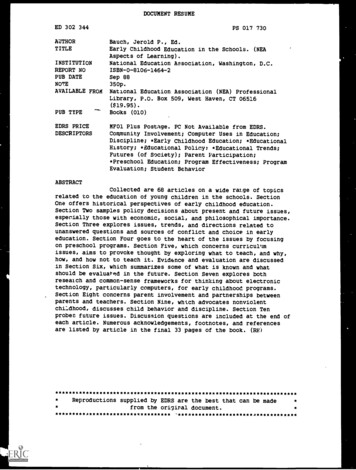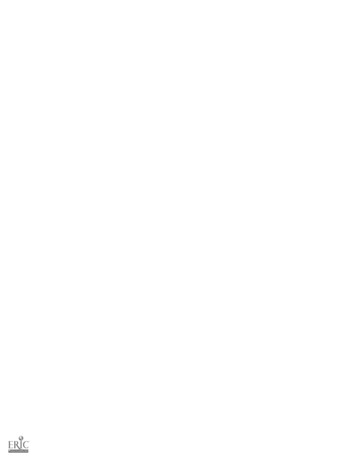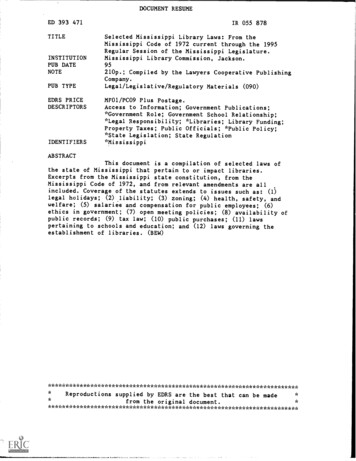
Transcription
DOCUMENT RESUMEED 302 344AUTHORTITLEINSTITUTIONREPORT NOPUB DATENOTEAVAILABLE FROMPUB TYPEEDRS PRICEDESCRIPTORSPS 017 730Bauch, Jerold P., Ed.Early Childhood Education in the Schools. (NEAAspects of Learning).National Education Association, Washington, D.C.ISBN-0-8106-1464-2Sep 88350p.National Education Association (NEA) ProfessionalLibrary, P.O. Box 509, West Haven, CT 06516( 19.95).BoOks (010)MF01 Plus Postage. PC Not Available from EDRS.Community Involvement; Computer Uses in Education;Discipline; *Early Childhood Education; *EducationalHistory; *Educational Policy; *Educational Trends;Futures (of Society); Parent Participation;*Preschool Education; Program Effectiveness; ProgramEvaluation; Student BehaviorABSTRACTCollected are 68 articles on a wide raLge of topicsrelated to the education of young children in the schools. SectionOne offers historical perspectives of early childhood education.Section Two samples policy decisions about present and future issues,especially those with economic, social, and philosophical importance.Section Three explores issues, trends, and directions related tounanswered questions and sources of conflict and choice in earlyeducation. Section Four goes to the heart of the issues by focusingon preschool programs. Section Five, which concerns curricul'imissues, aims to provoke thought by exploring what to teach, and why,how, and how not to teach it. Evidence and evaluation are discussedin Section Six, which summarizes some of what is known and whatshould be evaluated in the future. Section Seven explores bothresearch and common-sense frameworks for thinking about electronictechnology, particularly computers, for early childhood programs.Section Eight concerns parent involvement and partnerships betweenparents and teachers. Section Nine, which advocates nonviolentchildhood, discusses child behavior and discipline. Section Tenprobes future issues. Discussion questions are included at the end ofeach article. Numerous acknowledgements, footnotes, and referencesare listed by article in the final 33 pages of the book. (RH)*Reproductions supplied by EDRS are the best that can be madefrom the original document.
U S DEPARTMENT OF EDUCATIONOffice of Ed.k.ationai Research and ImprovementEDUCATIONAL RESOURCES INFORMATIONCENTEERIreproouced asThis document has beeneceivei from the person organ,zationoriginating itMinor changes have been made to improvereproduction quail'Points of view or opinions stated in thisdocu-ment do not necessarilyOERI position or policyWPECTS OF LEARNINGMato"PERMISSION TO REPRODUCE THISMATERIAL IN MICROFICHE ONLYHAS BUN GRANTED BYts1 E ATO THE EDUCATIONAL RESOURCESINFORMATION CENTER (MC)."represent officialse
Early ChildhoodEducationin the SchoolsJerold P. Bauch, EditorneatrateNational Education AssociationWashington, D.C.
To my motherfor a safe andhappy childhood.J.P.B.The editor and publisher will to extend their thanks to the authors and publishers who grantedpermission to use the material in this publication. Please see pp. 318-51 for a detailed listing ofpublishers and other copyright holders.Copyright 1988Nationa! Education Association of the United St: tesPrinting HistoryFirst Printing:September 1988NoteThe opinions exprzssed in this publication should not be construed as representing the policy orposition of the National Education Association. Materials published by the NEA Professional Libraryare intended to be discussion documents for educators who are concerned with specialized interestsof the profession.LIBRARY OF CONGRESSLibrary of Congress Cataloging-in-Publication DataEarly childhood education in the schools / Jerold P. Bauch, editor.cm.(NEA aspects of learning)p.Includes bibliographiesISBN 0-8106-1464-22. Public schools1. Early childhood educationUnited States.II. SeriesI. Bauch, Jerold P.United States.LB1140.23.E18 1988372'.21dc1988-19569CIP"EDP'
CONTENTSIntroduction, by Jerold P. Bauch7Section One: Historical Perspectivesof Early Childhood EducationEditor's Overview91.Early Childhood Education's Past as Prologue:Roots of Contemporary Concerns, by Bernard Spodek2. The European Roots of Early Childhood Education in North America,by Gary Woodill3. A Mini-History of Early Childhood Education, by Blythe F. Hinitz4. The Kindergarten in Historical Perspective,by S. Dianne Lawler and Jerold P. Bauch10142325Section Two: Policy Decisions About Presentand Future IssuesEditor's Overview295.Policy Options for Preschool Programs, by Lawrence J. Schweinhart,Jeffrey J. Koshel, and Anne Bridgman6. Early Childhood Development Programs: A Public InvestmentOpportunity, by Lawrence J. Schweinhart and David P. Weikart7. Quality: The Key to Successful Programs, by Daniel S. Cheever, Jr. ,and Anne E. Ryder303644Section Three: Issues, Trends, and DirectionsEditor's Overview8.50Trends in Early Childhood EducationPart I: Demographics,by Valora Washington519. Trends in Early Childhood EducationPort II: Instruction,by Valora Washington10. Early Childhood Education: Issues and Trends, by Paula Jorde11. Educating the Very Young: A Call for Clear Thinking, by David Elkind56606512. Preschool Children in the Public Schools: Good Investment? or Bad?13.14.1516.17.by Deborah Burnett StrotherDay Care and the Public SchoolsNatural Allies, Natural Enemies,by Bettye M. Caldwell71Let Children Start School When They're Ready! by Cynthia ParsonsIt Depends on Your Aim, by Raymond S. Moore81In Defense of Early Childhood Education, by David ElkindSynthesis of Research on School Readiness and Kindergarten Retention,by Lorric A. Shepard and Mary Lee Smith76828488
CONTENTSUses and Abuses of Developmental Screening andSchool Readiness Testing, by Samuel J. Meisels19. Educating Young Handicapped Children: What Can Ear:i ChildhoodEducation Contribute? by Anne H. Widerstrom18.95104Section Four: Preschool Programs110Editor's OverviewPublic Education for Preschoolers, by Diane Scott Jonesand Lynne Baker-Ward21. Should Four-Year-Olds Be in School? by Edward F. Zigler22. Pubh Schools and Four-Year-Olds: A Teacher's View,by Mary Hatwood Futrell23. Quality Four-Year-Old Programs in Public Schools,Position Statement of the Southern Association on Children Under Six . .24. Here Come the Four-Year-Olds! by Diane Dismuke25. Prekindergarten Programs for Four-Year-Olds:State Involvement in Preschool Education, by Carolyn Morado26. Safeguards: Guidelines for Establishing Programs for Four-Year-Olds inthe Public Schools, by The Natic,i.al Black Child Development Institute .27. Public School for Four-Years-Olds, by James L. Hymes, Jr2 ---, Full-Day or Half-Day Kindergarten? by Dianne Rothenberg829. ! Kindergarten in America: Five Major Trends,---. - by Sandra Longfellow Robinson30. Kindergarten Programs and Practices, Educational Research ServiceStaff Report31. NAEYC Position Statement on Developmentally Appropriate Practicein the Primary Grades, Serving Five- Through 5136140Section Five: The Curriculum for Young Children in SchoolEditor's Overview14632. Joint Statement on Literacy Development and Pre-First G. de, preparedby the Eady Childhood and Literacy Development Committee of the International Reading Association for ASCD, IRA, NAEYC, NAESP, NCTE 14733. Writing in Kindergarten and First Grade, by Mary Renck Jalongoand Sally Zeigler34. How Should Reading Be Taught in Kindergarten?by Patricia M. Cunningham35. "Success"ful Reading Instruction, by Carol J. George36. Hispanic Books/Libros Hispanicos, by Isabel Schon37. Learning Mathematics and Science Through Play, by Michael L. Henniger38. Montessori: Right or Wrong Abut Number Concepts?by Jerold P. Bauch and Huei-hsin Joyce HsuTheoretical FIRIIIM ,rk for Prescho31 Science Experiences,by Robert F. Smith40. Music in the Early Childhood Curriculum,by Manny Brand and David E. Fernie14915615715916216639.169174
Contents41. Appreciate the Drawing and Dictating of Young Children,by Annc Haas Dyson42. Encouraging Positive Social Interaction Among Young Children,by Dwight L. Rogers and Dorene Dome Ross43. Teaching with Less Talking: Learning Centers in the Kindergarten,by Barbara Kimes Myers and Karen Maurer44. Influences from the Past: Play in the Early Childhood Curriculum,by Margie L. Hardy and Laurie J. Greene45. Leading Primary Education Toward Excellence: Beyond Worksheetsand Drill, by Constance Kamii178187192198201Section Six: Evidence and EvaluationEditor's Overview20946. Effects of Program Models and Teaching Practices, by Douglas R. Powell21047.Evidence That Good Early Childhood Programs Work,by Lawrence J. Schweinhart and David P. Weikart48. The Promise of Early Childhood Education, by Lawrence J. Schweinhart,John R. Berrueta-Clement, W. Steven Barnett, Ann S. Epstein, andDavid P. Weikart49. Early Childhood Evaluation: What? Who? Why?by Doris Bergen Sponseller and Joel Fink216222226Section Seven: Electronic Technology for Early Childhood ProgramsEditor's Overview23150. Computers for Young Children? Perhaps,by Sandra Ansclmo and R. Ann Zinck23251. Computers and Young Children: A Review of Research,52.by Douglas H. Clements237Technological Priorities in the Education of Young Children,by Warren W. Buckleitner and Charles F. Hohmann245Section Eight: Parents and Community InvolvementEditor's Overview24953. In Designing a Preschool Program, We Went Straight to the Source:Parents, by Robert L. Zorn25054.Is 'Parenting' Essential to Good Teaching? by James P. Comer, M.D.55. Making Conferences Work for Parents, Teachers, and Children,by Gail Bjorklund and Christine Burger56.Innovation in Parent Involvement: Using High Tech to Connect Parentsand Teachers, by Jerold P. Bauch25325926457. Literacy Environments: Bridging the Gap Between Home and School,58.by Jon Shapiro and Ray Doiron266Communicating with Parents About Beginning Reading Instruction,by Dorene D. Ross and Elizabeth Bondy27141I
CONTENTSSection Nine: Child Behavior and DisciplineEditor's Overview59The Banning of Corporal Punishment: In Child Care, Schooland Other Educative Settings in the United States, by John R. Cryan60. A Cognitive Approach to Benavior Management, by Jerold P. Bauch61. Corporal Punishment in the Schools, by John H. Meier62. Child Abuse and Neglect: Preventim and Reporting,by Barbara J. Meddin and Anita L. Rosen .277278284287290Section Ten: The FutureEditor's Overview29563. Societal Influences on Children, by Joan Isenberg296k4. Developmental and Experiential Programs: The Key to Quality Educationand Care of Young Children, by Barbara Day and Kay N. Drake65. Upon What Can We Build Our Children's Educational Future?by Walter Hodges66. BACK to Basics or FORWARD to Fundamentals? by Alice V. Keliher . . .30230530967. The Future of Education, by Wilson Riles68. Early Schooling and the Nation's Future, by Ernest L. Boyer311Acknowledgments, Footnotes, and References318314
INTRODUCTIONA new baby in a family is always cause for greatexcitement, reorganization, and emotional reac-tion. The field of early childhood education is likethat too: each new event makes waves, causesextensive communication, and serves to renew thefield and the people who work with young children. There is a surprising continuity in the mainideas and basic qualities of early education, howev-er. This book marks the end of a quarter centuryof wild innovation, astou. ding growth, and rapidchange. Yet what remains from all that "newness"is a better-informed commitment to the very qualities that have marked early childhood educationfor centuries. This is not to say that all the issueshave been resolved; far from it. It may fairly besaid that the more things change, the more theystay the same in early education.The education of our youngest continues toprogress in a state of dynamic equilibrium, wherethe dialectic between seemingly contradictory ideasproduces new insight. From the very beginning,the balance between the needs of the child andthe expectations of the society have been a primarysource of argument. There is agreement that everyyoung child has a right to optimal development ina safe and nurturant environment. There is disagreement about what is optimal, how we canassure security and support for every child, andwhat is th right blend of family roles and organized education in the process.There is agreement that young children progressthrough developmental stages with unique charac-teristics, but disagreement even about the namesof the stages and the meaning of their effects onchild growth. There is agreement that young children master their environment through a complexof thought, language, social relationships, andphysical exploration. There is disagreement abouthow parents and teachers should guide this process, when intervention is necessary or desirable,and how to facilitate development. There is agreement that every planned educational experienceshould help prepare the child for success in thefuture, but disagreement about how to make anenduring contribution to the child that is vital forthe present and the future.It is the intent of this collection to representboth the agreements and disagreements that causeexcitement and perennial interest in the educationof young children in the schools. In the true senseof the dialectic, the answers are the source of thenew questions. A thorough reading of this bookshould produce numerous answers and many intriguing questions. The diversity that makes thefield dynamic is well represented, and the consen-sus on major themes is also present. As in thechild, each reader must construct a reality frominteractions with the information and ideas thatare presented here. There is no point in flipping tothe last pages to find the ultimate answer, becausethe search for excellence in the education of ouryoungest is a journey, not a destination. Thus, thecollection offers readers a chance to construct orreconstruct views on how young children should beeducated, and tf find places where what theybring to the reading connects with what the authors have to say.As if developing an individual perception of thefield and Ending one's place in it were notdifficult enough, the internal and external forcesthat shape early childhood education are also represented. Ideas have a history and that history isrepresented in Section One. Policy decisions, especially those of economic, social, and philosophicalimportance are sampled in Section Two. Unanswered questions and sources of conflict and choiceare the topics organized in Section Three. SectionFour goes to the heart of the issues represented inthe titleyounger children in school programs. Itis highly representative of the seeming diversity ofviewpoint that adds up to sensible agreementabout the nature and quality of any early educational experience.Section Five is intended to challenge and leadthe reader to further study. Wha to teach, why,how, and how not to are the themes of thesepresentations; each one should be provocative.Section Six summarizes some of what we know sofar, and what we should be evaluating in thefuture. Since early childhood education in theschools is a prime candidate for electronic technology in the learning setting, Section Seven exploresboth research and common-sense frameworks forthinking about computers. Because parents arecertainly the child's first teachers, Section Eight isabout parent involvement and partnerships be7J
INTRODUCTIONtween parents and teachers. Section Nine is obviously a biased group of chapters that stand togeth-er in favor of a nonviolent childhood for ourchildren. And the final section, Ten, uses some oftoday's realities as stepping stones toward the near-by seeking new insight from old arguments.We hope that this collection provides some fuelto the fires of discussion and some illumination tohelp light the way for early c'ildhood education inthe schools.term future. It will come as no surprise to thereader that writers about the future connect theirspeculations to the past, to trends and issues, topolicy questions, to curriculum and instructionthemes, and to other topics found in earlier chapters. Remember, this is a field that makes progress810-JEROLD P. BAUCHProfessor of Early Childhood EducationPeabody College of Vanderbilt UniversityNashville, Tennessee
Section One: Historical Perspectivesof Early Childhood EducationEditor's Overview1,2.3.4.9Early Childhood Education's Past as Prologue:oots of Contemporary Concerns, by Bernard Spodek10The European Roots of Early Childhood Education in North America,by Gary Woodill14A Mini-History of Early Childhood Education,by Blythe F. Hinitz23The Kindergarten in Historical Perspective,by S. Dianne Lawler and Jerold P. Bauch25EDITOR'S OVERVIEWEarly childhood education in the schools is anidea with a div'rse and interesting history; thissection explores that history. The authors discusssocial reform, religious beliefs, national policy, andcommon sense as some of the sources of ourhistorical heritage.The past is an important touchstone for allprofessionals; therefore, the aistorical selections included here span a period of several hundred years.Since the emphasis is on recent developments inthe field of early childhood education, however,the writers concentrate on those events that giveshape and substance to the present. Spotlek setsthe stage by giving the broad perspective andWoodill fills in the details. Hinitz's quick summa-ry is a transition to the most dramatic period ofour past: 1960 to the presenta short period oftime, historians remind us, that saw more changethan any other period in human history. Finally,Lawler and Bauch trace the specific history of thekindergarten, documenting the changes' that havetaken place.As our society and our culture are re-createdthrough the education of young children in theschools, the need for thoughtful and informeddecisions is essential. The history of the fieldprovides a critical context for evaluating the present and planning the future; we are not likely todo either very well without an accurate understand-ing of what has gone before.11
1. EARLY CHILDHOOD EDUCATION'S PAST AS PROLOGUE:ROOTS OF CONTEMPORARY CONCERNSby Bernard SpodekI have come to better understand myself and thenature of the early childhood field in the historicalcontext of my own developmental experiences. Mygrowing identification with my culture and countryfrom celebrating holidays is an example 3f thisprocess.Passover has always been a very special holiday.It celebrates the flight of die Jewish people fromslavery in Egypt, an event with symbolic meaningfor many people. Each year, Jewish families gatherat home, retell the story of the Exodus, and eatspecial foods. Even as a child, I could feel thateach generation of my family had struggled forsuch freedom. The ritual provides me with a directsense of my history, back to the survivors of theflight from Egypt.Thanksgiving is another holiday that I remembervividly, although it was mosey a school eventduring my childhood. Each November, we heardthe story of the joint celebration of Pilgrims andIn :ions, drew pictures, made paper hats and collars, and cooked a feast. Nevertheless, Thanksgiving seemed an alien, somewhat empty holiday tome because I grew up with different rituals: myparents came from Eastern Europe, not England.FINDING OUR ROOTSAs early childhood educators we are committedto the educatiot., development, and well-being ofyoung children because they cannot protect them-selves We can better understand our field byseeing how it, like other organizations or individuals, has become a distinctive institution withinsociety.According to Clark (1970), an institution initially achieves its character either by drifting into oractively seeking its role. The organization's missiongrows out of its statement of purpose and lends asense of direction. This common sense of missioncommitment to the education, development,and well-being of young childrenholds the fieldof early childhood edmation together.A successful
DOCUMENT RESUME PS 017 730. Bauch, Jerold P., Ed. Early Childhood Education in the Schools. (NEA Aspects of Learning). National Education Association, Washington, D.C. ISBN-0-8106-1464-2 Sep 88. 350p. National Education Association (NEA) Professional Library, P.O. Box 509, West Haven, CT 06516 ( 19.95). BoOks (010) MF01 Plus Postage. PC Not .











